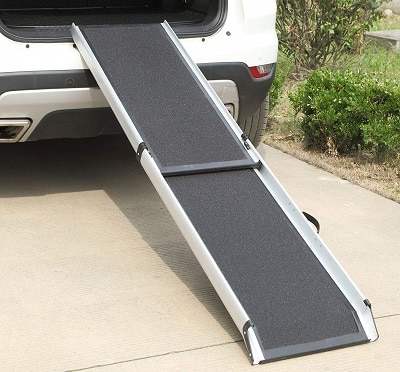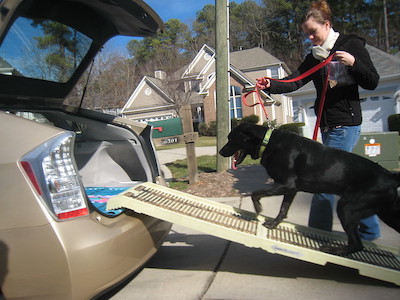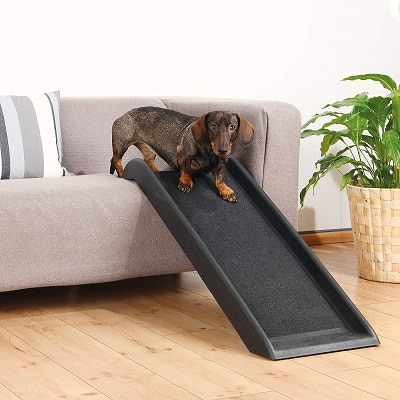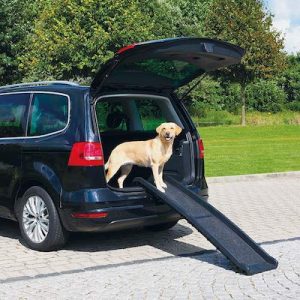As pet parents, we want our furry friends to be happy and healthy, but as they age or face mobility challenges, they might find it difficult to climb stairs or jump onto the bed or couch. That’s where ramps come in.
Buying a dog ramp is the first step in helping your dog scale different heights safely and easily. Most senior dogs or dogs with mobility problems will baulk at the sight of this metal or plastic monstrosity.
Sometimes, a dog may just scale up naturally, but in general, they will need some training and guidance to use the product you’ve just parted with your cash for. This article will help you train your dog to use the dog ramp.
Let’s get started!
Preparing your Dog for Ramp Training
Before diving into ramp training, we must ensure our dogs are comfortable with the setup. It’ll help them succeed and reduce the likelihood of any fears or hesitations when using a ramp.
Here are some tips for preparing your dog for ramp training:
1. Build trust and comfort.
If your dog isn’t used to new objects, it can be helpful to introduce them to different items, such as new toys.
Once comfortable with their new toys, they’ll be more likely to approach and use a ramp without hesitation.
2. Use only positive reinforcement.
Reward your dog with treats or praise when they approach or interact with the ramp, even if they don’t use it initially.
It’ll help your dog associate the ramp with positive experiences and make them more willing to try it out.
3. Be patient and try to understand your dog’s learning style.
Every dog learns differently, so it’s important to understand your dog’s learning style and cater to its needs. Some dogs may be more visual learners, while others may respond better to hands-on training.
Observe your dog’s behaviour and adjust your training techniques accordingly. Remember to always be patient and consistent with your training, as it can take time for your dog to become comfortable with the ramp.
Teaching Your Dog to Use a Ramp
Now that you’ve prepared your dog for ramp training, it’s time to begin the actual training process.

Step 1: Introduce the ramp.
Start by placing it flat on the ground and allowing your dog to sniff and explore it. You can also place treats on the ramp to encourage your dog to approach it and associate it with positive experiences.
Step 2: Encourage your dog to step on the ramp.
Once comfortable around it, encourage them to step on it by placing a treat at the bottom. Gradually move the treat up the ramp, encouraging your dog to follow.
If they don’t respond, use the ramp yourself when they’re around. And do it repeatedly. Go up and down safely and calmly, and carry treats with you.
If your dog watches at this point and wants to join in, be ready to reward them if they make it onto the ramp.
Step 3: Repeat and increase the incline.
Continue to repeat the process of placing treats further up the ramp, gradually increasing the ramp’s incline. Start with a low incline and gradually increase it as your dog becomes more comfortable.
As they progress, the incline increases slowly, so they don’t notice the change as much. Eventually, you’ll be able to get them to practice with the incline as it should be.
Pro Tip: Place the ramp on grass or carpet, so it doesn’t slide, and use wooden beams or breeze blocks to add the incline. Be extra careful to use something heavy and strong that won’t move easily to increase the incline. Using the ramp on a sofa is another great idea, as it’s wide and secure.
Step 4: Walk your dog up the ramp.
Once your dog is comfortable walking up the ramp with treats, try walking alongside them with a leash. This will give your dog a sense of security and help them feel more confident.
Don’t force them up. Just gently direct them towards it. If they make any kind of progress, give them loads of praise and treats.
If they end up getting to the top, that’s amazing! At this point, I’d recommend taking them somewhere as a treat, so they begin to think, “If I get to the top of the ramp, that means good things!”.

Step 5: Walk them down the ramp.
I know it might sound like the same thing, but it’s not.
Heading down the ramp is more daunting than going up because it’s easier to fall down than it is. Get their lead on and be prepared for a long and patient session. Always have your treats on hand to reward them for any progress made.
Step 6: Practice! Practice! Practice!
Once your dog is comfortable walking with you, practice going up and down the ramp together. Be sure to provide positive reinforcement for good behaviour, such as treats and praise.
Read More: Best Dog Ramps For UK Dog-owners (UPDATED)
Troubleshooting common issues
While training your dog to use a ramp, you may encounter a few challenges. It’s essential to be patient and consistent throughout the process.
Here are some common issues you may encounter and how to address them:
1. Fear or Hesitation
Dogs like to be on solid ground. It’s stable, and it’s what they are used to. They’re not born daredevils and are afraid of what they don’t know.
Moving can be uncomfortable for senior dogs and those with mobility problems, such as those who need exercise due to hip dysplasia. Hence, they will be more anxious about scaling a ramp.
That’s why it’s important to train them that using the dog ramp helps them achieve something desirable, such as getting in the car or getting to a comfortable spot at the end of the ramp. It’s a means to an end, and that is exactly what we want the dogs to know.
Start by placing the ramp on the ground and letting your dog sniff and explore it at their own pace. Use positive reinforcement techniques, such as verbal praise and treats.
Taking the time and going at your dog’s pace during ramp training is important. Keep training sessions short and frequent to avoid overwhelming your dog. Rushing the process can cause anxiety and setbacks.
2. Physical limitations

Some dogs may have physical limitations that make it difficult to use a ramp, such as joint problems or mobility issues.
In these cases, it’s essential to consult with your veterinarian to ensure that a ramp suits your dog’s specific needs.
If your dog is physically limited, you can try the following steps:
- Use a ramp with a gentle incline to minimise any strain on your dog’s joints.
- Consider using a harness or a sling to support your dog as they climb the ramp.
If your dog has a medical condition that limits its mobility, consult with your veterinarian to determine if there are any alternative solutions.
Ramp vs Stairs: What’s best for senior dogs?
| Ramp | Stairs |
| Provides a gradual incline, reducing stress on joints and muscles | Can be difficult for dogs with mobility issues, arthritis, or other joint problems |
| Can be easier for dogs to learn to use | Can be more familiar to dogs accustomed to using stairs |
| Can be used both indoors and outdoors | Takes up less space than a ramp |
| May be more expensive than stairs | More economical |
| May require more maintenance or cleaning | Can be dangerous if the dog slips or falls |
First and foremost, it’s crucial to understand the specific needs of your senior dog. For example, if your dog has arthritis or hip dysplasia, it may benefit from a ramp’s gentle incline instead of the stairs’ impact on its joints.
Read More: How to make a cheap DIY dog ramp at home?
Another benefit of using a ramp for senior dogs is that it provides a wider surface area for them to walk on, reducing the risk of slipping and falling.
Ramps are also a great option for dogs hesitant or fearful of stairs, as they offer a more gradual and less intimidating way to navigate elevated surfaces.
In comparison, stairs can be a better option for senior dogs who still have good mobility but may need a little extra support. Stairs are also more space-efficient and can better fit smaller living spaces.
Generally, deciding between a ramp or stairs will depend on your senior dog’s specific needs and preferences. Considering their physical limitations, comfort level with different surfaces, and existing health conditions is important.
Consulting with your veterinarian will also provide valuable insight into what type of mobility aid will be best for your senior dog.




